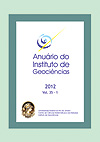The importance of preserving bioclastic accumulations of the coastal plain of the Una river, county of Cabo Frio and Armação dos Búzios, Rio de Janeiro, Brazil
DOI:
https://doi.org/10.11137/2012_1_58_67Abstract
In the coastal plain of the Una river, county of Cabo Frio and Armação dos Búzios, are found layers of shells of great lateral extent, related to the latest Holocene marine transgression that occurred approximately 5.000 years B.P. The aim of this study is to characterize the distribution of the bioclastic accumulations in this region, for palaeoenvironmental studies and identification of variation of relative sea level. In this area has been found so far six locations where outcrop bioclastic layers composed primarily of molluscs: outfall of the Una river; drainage channel of the Marina Porto Búzios; Tauá Reserve; Condominium Portal de Buzios;Campos Novos; Araçá Farm. The deposit Tauá Reserve is a Site of Geology and Paleontology with description approved by SIGEP, and is considered one of the most important records during the Holocene marine transgression across the State of Rio de Janeiro. However, other deposits found in the region have special features that refer equal value, mainly due to differences regarding the taxonomic composition and habit of life and age of the mollusc deposits. Therefore, the preservation of these deposits is extremely important, because they are source material for taxonomic, palaeoenvironmental, taphonomic and geochronological studies. Because they are considered biological indicators of change in relative sea level, also have a great importance for the didactic and scientific research related to this topic. Comparative studies involving aspects of taxonomic, paleoecological, taphonomic and geochronological deposits in the coastal plain of the river Una are underway and results will contribute for understanding the processes palaeoenvironmental and change in relative sea level in the region of Cabo Frio.Downloads
Download data is not yet available.
Downloads
Published
2012-06-01
How to Cite
Cunha, A. M. da, Castro, J. W. de A. and Dias, F. F. (2012) “The importance of preserving bioclastic accumulations of the coastal plain of the Una river, county of Cabo Frio and Armação dos Búzios, Rio de Janeiro, Brazil”, Anuário do Instituto de Geociências. Rio de Janeiro, BR, 35(1), pp. 58–67. doi: 10.11137/2012_1_58_67.
Issue
Section
não definida
License
This journal is licensed under a Creative Commons — Attribution 4.0 International — CC BY 4.0, which permits use, distribution and reproduction in any medium, provided the original work is properly cited.















